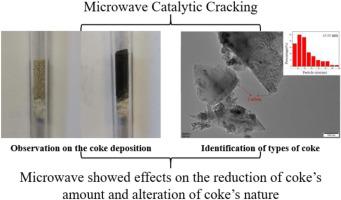Applied Catalysis A: General ( IF 4.7 ) Pub Date : 2021-08-18 , DOI: 10.1016/j.apcata.2021.118325 Jian Li 1 , Liguo Jiao 1 , Zhiyu Li 1 , Beibei Yan 1, 2 , Guanyi Chen 3, 4 , Sarwaich Ahmed 1

|
Tar is one of the biggest obstacles for commercial application of biomass gasification. Microwave catalytic cracking shows potential for not only removal but also conversion of tar. However, the coke formation under microwave has not been investigated. In the present work, a microwave applicable catalyst, Ni-Ce@SiC, was prepared. The effects of temperature and inlet tar concentration on toluene and phenol conversions were investigated under both microwave and conventional heating conditions, and the influences on coking rate were also focused. Results showed that increasing temperature and reducing inlet tar concentration improved tar conversion. Inlet tar concentration and cracking of phenol typically caused more coke deposition. Based on the characterizations of the spent catalysts, the microwave could eliminate the coke deposition and alter the coke types. The mechanism of microwave on the coke suppression was revealed. This study provids an in-depth understanding of the coke formation during the microwave process, and also builds foundation for the design and operation of catalytic process.
中文翻译:

不同生物质模型焦油催化裂化过程中焦炭沉积的研究:微波的影响
焦油是生物质气化商业化应用的最大障碍之一。微波催化裂化显示出不仅去除焦油而且转化焦油的潜力。然而,尚未研究微波下的焦炭形成。在目前的工作中,制备了一种适用于微波的催化剂 Ni-Ce@SiC。在微波和常规加热条件下研究了温度和入口焦油浓度对甲苯和苯酚转化率的影响,并重点关注对焦化率的影响。结果表明,升高温度和降低入口焦油浓度可提高焦油转化率。入口焦油浓度和苯酚裂解通常会导致更多的焦炭沉积。根据废催化剂的表征,微波可以消除焦炭沉积并改变焦炭类型。揭示了微波抑制结焦的机理。该研究为深入了解微波过程中焦炭的形成提供了依据,也为催化过程的设计和操作奠定了基础。










































 京公网安备 11010802027423号
京公网安备 11010802027423号